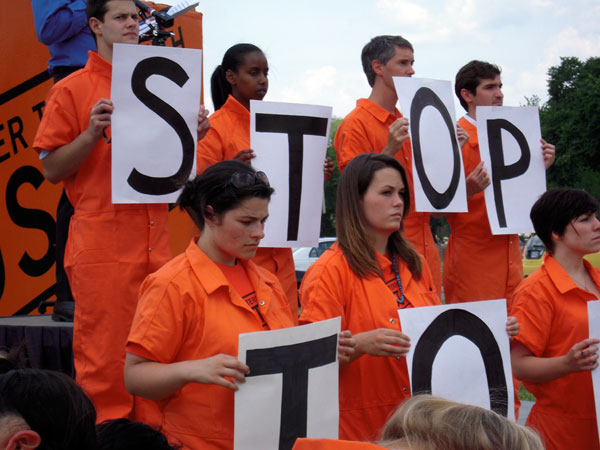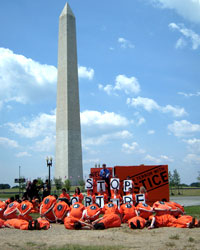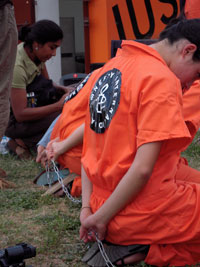Amnesty Brings Gitmo Cell to U.S.
In its latest effort to push the Bush administration into closing the Guantanamo Bay detention facility, Amnesty International is challenging Americans to
Jul 31, 20206.9K Shares432.2K Views
Stop Torture: Amnesty International Protesters on the National Mall (Spencer Ackerman)
In its latest effort to push the Bush administration into closing the Guantanamo Bay detention facility, Amnesty International is challenging Americans to become ersatz detainees.
The human-rights organization is taking a replica of an actual Guantanamo cell around the country for what it calls the “Experience Guantanamo” project. Weighing nearly a ton, the cell is a facsimile of the one that housed David Hicks, the Australian detainee who was extradited from Guantanamo in 2007 after spending nearly five years there. The cell’s dimensions — 10 feet long, six feet wide and eight feet high — replicate those at Guantanamo’s Camp Five, the first facility in the detention complex modeled on a maximum-security Indiana prison.
On Wednesday, Amnesty brought the cell to the National Mall in Washington. In the shadow of the Washington Monument, Larry Cox, executive director of Amnesty International, USA, urged the closing of the facility. “At times, discussions about Guantanamo seem ethereal at best,” he told a crowd of about 100, mostly Amnesty members and media. “But when you stand inside the constricting Guantanamo cell replica, the reality of what is happening hits you and it is overwhelming. How is it possible that our government considers this — solitary confinement, stress positions, lack of habeas corpus and indefinite detention with no access to a real court –as what we wanted when we asked for justice?”
As he spoke, several dozen Amnesty volunteers and staff members from its Washington and New York offices, wearing the orange jumpsuits of so-called “non-compliant” Guantanamo detainees, knelt in mock-”stress positions” or held placards that spelled out, “Stop Torture.”
One visitor to Amnesty’s demonstration had a tumultuous history with the detention complex. Army Capt. James Yee was a Muslim chaplain at Guantanamo in 2002 and 2003, when he was arrestedon suspicion of espionage and detained at the Naval brig in Charleston, S.C., for six months. All charges were eventually dropped. “I lived in a cell like this in South Carolina,” said Yee. Seeing the replica, he said, “brought back “vivid nightmares.”
Yee explained that he had come to Washington primarily for a family vacation, but also to watch a House Judiciary panel tomorrow that is expected to feature the Guantanamo defenders David Addington, chief of staff for Vice President Dick Cheney, and John Yoo, the former Justice Dept. lawyer who advocated torture in an infamous August 2002 memo. “I would ask them if, at any time, they had any concern for the reputation of our country,” he said.
Cox of Amnesty, had a more direct challenge to Addington and Yoo. “I would make them sit in that cell,” he said.
The cell’s crosscountry trip began in Miami on May 8, said Amnesty spokeswoman Sharon Singh, and it has already made stops at Philadelphia and Portland, Maine. Next, it will travel through the Midwest, though no specific dates have been confirmed. The tour “will wrap up when Guantanamo closes,” Singh said.
In July 2005, I visited Guantanamo Bay for a four-day, military-approved tour, and spent about an hour at Camp 5. Amnesty’s cell on the Mall matched my recollection in terms of its size. Built for a single detainee, the all-white concrete structure has a concrete shelf jutting out about knee-high that serves as a sleeping platform, topped by a thin blue plastic mattress.
The chamber’s other features include a steel toilet bowl and a carved-out portion of wall about the size of a man’s forearm that serves as a window. In the summer heat and humidity of Washington — significantly milder than Guantanamo — the cell heats rapidly, and several visitors dripped sweat within minutes of walking into it.
Most detainees are permitted about an hour of exercise daily, meaning they are confined to these cells for 23 hours per day. About 270 people are today detained at Guantanamo Bay, down from approximately 800 when the facility opened for use in the war on terrorism, in January 2002.
The cell will remain on the Mall, open for public touring, until Sunday. After it leaves Washington, Amnesty is planning a “Lobby Week” to send its activists to Capitol Hill “to meet with representatives and staff, urging them to shut down Guantanamo,” Singh said.
Another visitor to the cell was Orlando Tizon, a community organizer from the Philippine island of Mindanao, who was tortured in the 1980s by the regime of former dictator Ferdinand Marcos. “It’s very sad that the media and the government is treating torture as a joke,” Tizon said. “Waterboarding is not a dunk in the water, and it’s not a frat hazing.” Tizon, now a staffer with the human-rights group Torture Abolition and Survivors Support Coalition International, is scheduled to speak Wednesday evening at an Amnesty rally on the Mall.
Last week, the Senate Armed Services Committee releasedformerly classified memoranda detailing how Bush administration officials transformed programs that train U.S. Special Forces to resist torture into a regimen for torturing terrorism detainees at places like Guantanamo Bay. Today, a coalition of religious groups, military officers and former officials from the Carter, Reagan, Bush I, Clinton and Bush II administrations issueda letter urging the next president to ban all interrogation methods not consistent with the Geneva Conventions-complaint Army Field Manual on Interrogation and ensure due-process rights for terrorism detainees in U.S. civilian courts.
Looking at the cell on the Mall, Cox said that Guantanamo had proven counterproductive to the war on terrorism. “It’s a recruiting poster for terror instead of a deterrent,” he said.

Hajra Shannon
Reviewer
Latest Articles
Popular Articles


